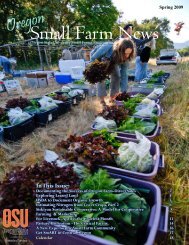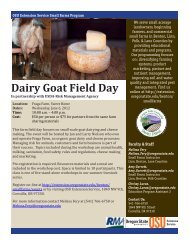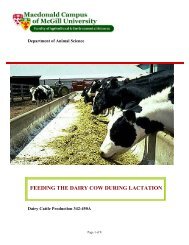Small Farm News - Oregon Small Farms - Oregon State University
Small Farm News - Oregon Small Farms - Oregon State University
Small Farm News - Oregon Small Farms - Oregon State University
You also want an ePaper? Increase the reach of your titles
YUMPU automatically turns print PDFs into web optimized ePapers that Google loves.
Managing Summer Weeds in Pastures<br />
By: Melissa Fery<br />
Pesky weeds often go undetected<br />
in pastures, until summertime<br />
when they’re in full bloom. The<br />
blaze of color, purple Canada<br />
thistle, white Queen Anne’s lace<br />
or the yellow blooms of tarweed<br />
can make a landowner jump into<br />
action. Unfortunately, when weeds<br />
are blooming, most control methods<br />
are not very effective. Often, the<br />
best that can be done at this time is<br />
to mow the flowers off before seed<br />
is set to reduce the spread and then<br />
prepare a management strategy.<br />
The first step in developing a plan<br />
for weed management is to properly<br />
identify the problem plants. Once<br />
identified, the second step is to take<br />
the time to learn about the plant’s<br />
life cycle and biology. For example, find out if the<br />
weed is an annual, biennial or perennial plant. Also be<br />
sure to study up on how the plant reproduces. Does<br />
the weed reproduce via seeds, vegetatively by a portion<br />
of the plant like a root, stem or leaf, or both? Canada<br />
thistle for example, is able to reproduce from a tiny root<br />
fragment and by seeds. Hand pulling or hoeing this<br />
troublesome weed may only create a larger thistle patch.<br />
Canada thistle in pasture. Learning to identify problem weeds in early growth<br />
stages will help in choosing effective control methods.<br />
Photo provided by Melissa Fery<br />
Management<br />
Handbook is a great<br />
resource to help<br />
determine which<br />
control measures<br />
are effective on<br />
specific weeds. The<br />
2007 handbook is<br />
accessible on-line<br />
at http://weeds.<br />
ippc.orst.edu/pnw/<br />
weeds. Additional<br />
weed publications<br />
are available at<br />
http://extension.<br />
oregonstate.edu/<br />
catalog/.<br />
Armed with some basic information about your specific<br />
weeds, a year-round management plan can help<br />
determine what combination of weed control practices<br />
is best. Your specific plan may include mechanical,<br />
biological, cultural and/or chemical controls. No matter<br />
what the control measure, success in reducing weed<br />
populations requires attacking the plant when it is most<br />
susceptible. You’ll want to be ready and plan ahead for<br />
proper timing. Walking the pastures and being able to<br />
identify weeds in an early growth stage will give you the<br />
upper hand.<br />
Your local OSU Extension Service is available<br />
to help you identify weeds. Investing in a good<br />
resource book with color pictures will also help with<br />
weed identification. The Pacific Northwest Weed<br />
A Willamette Valley Pasture<br />
Photo provided by Melissa Fery<br />
<strong>Oregon</strong> <strong>Small</strong> <strong>Farm</strong> <strong>News</strong> Vol. II No. 2 Page 3















